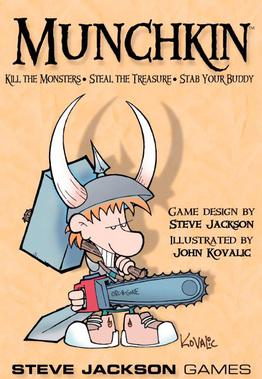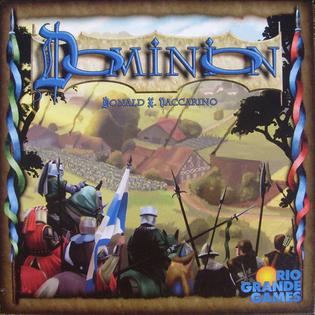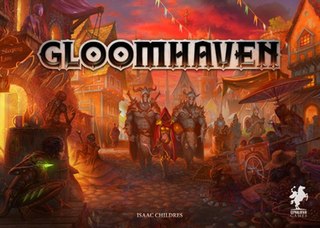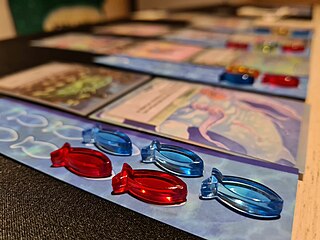
The Fantasy Trip (TFT) is a fantasy tabletop role-playing game designed by Steve Jackson and published in segments by Metagaming Concepts starting in 1977 and culminating in 1980. In 2019, Steve Jackson Games republished it as The Fantasy Trip Legacy Edition.

The Yu-Gi-Oh! Trading Card Game is a collectible card game developed and published by Konami. It is based on the fictional game of Duel Monsters created by manga artist Kazuki Takahashi, which appears in portions of the manga franchise Yu-Gi-Oh! and is the central plot device throughout its various anime adaptations and spinoff series.
Several video games based on the Magic: The Gathering franchise exist for multiple systems. Some have attempted to translate the card game to electronic play nearly exactly; others have taken more liberties and drawn more from the setting than the actual rules of the card game. Benefits of successful video game versions of the card game include convenience, practice, and challenge. However, artificial intelligence for a game such as Magic is an extremely hard problem, and such software usually must be continuously updated to stay current with recently released card sets. Video game versions often expand on artwork, and may include unique cards that rely on randomness, effects which would be difficult or annoying to duplicate in real life.

Munchkin is a dedicated deck card game by Steve Jackson Games, written by Steve Jackson and illustrated by John Kovalic. It is a humorous take on role-playing games, based on the concept of munchkins.

Arkham Horror is a cooperative adventure board game designed by Richard Launius, originally published in 1987 by Chaosium. The game is based on Chaosium's roleplaying game Call of Cthulhu, which is set in the Cthulhu mythos of H.P. Lovecraft and other horror writers. The game's second edition was released by Fantasy Flight Games in 2005, with a third edition in 2018.

Dominion is a card game created by Donald X. Vaccarino and published by Rio Grande Games. Originally published in 2008, it was the first deck-building game, and inspired a genre of games building on its central mechanic. Each player begins with a small deck of cards, which they improve by purchasing cards from a common supply that varies from game to game. Cards can help the player's deck function, impede their opponents, or provide victory points. As of December 2022, fifteen expansions to the original Dominion have been released.

Sentinels of the Multiverse is a cooperative card game published by Greater Than Games and released at Gen Con 2011. Players control a team of comic book-style heroes battling a villain. Each player controls one or more heroes, while a villain and environment deck each run themselves. A given game includes 3 to 5 heroes, 1 villain and 1 environment, which can be mixed and matched to create a number of different scenarios. The core game comes with 10 heroes, 4 villains, and 4 environments. The board game has also been made into a video game.

Puzzle Strike: Bag of Chips is a designer dedicated deck card game created by David Sirlin, inspired by Dominion and Super Puzzle Fighter II Turbo. It features asymmetric gameplay, and uses specially printed chips in place of cards.
Yomi: Fighting Card Game is a designer card game created by David Sirlin, inspired by Super Street Fighter II Turbo, which Sirlin also worked on. “Yomi” is Japanese for “reading,” as in reading the mind of the opponent. The Yomi card game is designed to distill the high-level mind games from fighting game into a simple card game. It features asymmetric gameplay, and makes use of cards with multiple options.

Star Realms is a card-based deck-building science-fiction tabletop game, designed by Rob Dougherty and Darwin Kastle and published in 2014 by Wise Wizard Games. The game started out as a Kickstarter campaign in 2013. The goal of Star Realms is to destroy opponents by purchasing cards using "trade" points and using these cards to attack an opponent's "authority" using "combat" points. The game takes place in a distant future where different races compete to gain resources, trade and outmaneuver each other in a race to become ruler of the galaxy.

Hand of Fate is an action role-playing roguelike deck-building game developed and published by Australian studio Defiant Development for Linux, macOS, Microsoft Windows, PlayStation 4, and Xbox One, released via early access on 7 July 2014, and then in the full release on 17 February 2015. A PlayStation Vita version was announced but ultimately cancelled due to development issues.

The Elder Scrolls: Legends is a free-to-play digital collectible card video game, published by Bethesda Softworks for Microsoft Windows, iOS, macOS and Android in 2017.
Dark Souls – The Board Game is a miniature-based exploration board game created by Steamforged Games. It was released in April 2017 and is based on the Dark Souls video game series by FromSoftware and Bandai Namco Entertainment. A crowdfunding campaign raised over £3.7 million was used to fund the project.
Bears vs Babies is a card game created by Elan Lee and Matthew Inman, who also created Exploding Kittens. Inman is also the founder of the website The Oatmeal.

Faeria is a digital collectible card and turn-based strategy game that takes place on a dynamic playing board set in a fantasy universe. The game was developed by Abrakam, and released for desktop platforms in 2017, for Xbox One and Nintendo Switch in August 2020 and for PlayStation 4 in November 2020. The game was well received by critics, holding a score of 80/100 on reviews aggregation website Metacritic.

Hearthstone is a digital collectible card game released by Blizzard Entertainment in 2014, available for Microsoft Windows and macOS PCs and iOS and Android smartphones. The game is free-to-play, with players gaining in-game currency and card packs via winning matches and completing quests, while real-world money can be spent to acquire additional card packs and cosmetic items. The game has been critically well-received and financially successful, estimated in August 2017 to earn nearly US$40 million per month. As of November 2018, Blizzard has reported more than 100 million Hearthstone players. Blizzard has continued to expand the game with the addition of multiple expansions, adventures and game modes.

Gloomhaven is a cooperative board game for one to four players designed by Isaac Childres and published by Cephalofair Games in 2017. It is a campaign-based dungeon crawl game including a narrative campaign, 95 unique playable scenarios, and 17 playable classes. Since its introduction the game has been acclaimed by reviewers, and has been described as one of the best board games ever made.

The Binding of Isaac: Four Souls is a card game designed by Edmund McMillen, with additional designs by Danielle McMillen and Tyler Glaiel. Based on the indie video game The Binding of Isaac, players control one of several characters - Isaac, Judas, Maggy, or Cain - as they defeat bosses to collect Lost Souls. Each character has abilities that impact either them or other players, and players may work cooperatively to defeat bosses and enemies. The first player to acquire four souls wins. A Kickstarter campaign launched on June 27, 2018, and broke its funding goal of $50,000 within the first 1.5 hours.

Oceans is a nature-themed strategy board game published in 2020 by North Star Games. It is a game in the Evolution series.

Cartographers is a roll and write board game designed by Jordy Adan and published in 2019 by Thunderworks Games. It is part of the Roll Player universe. In the game, players aim to draw terrains based on drawn cards that award points based on the relevant letter cards. The game received positive reviews, and was nominated for the Kennerspiel des Jahres, but lost to The Crew. It was also runner-up to Parks for the Best Family Game of the 2019 Board Game Quests Awards. An app for solitary play was released in 2020.
















